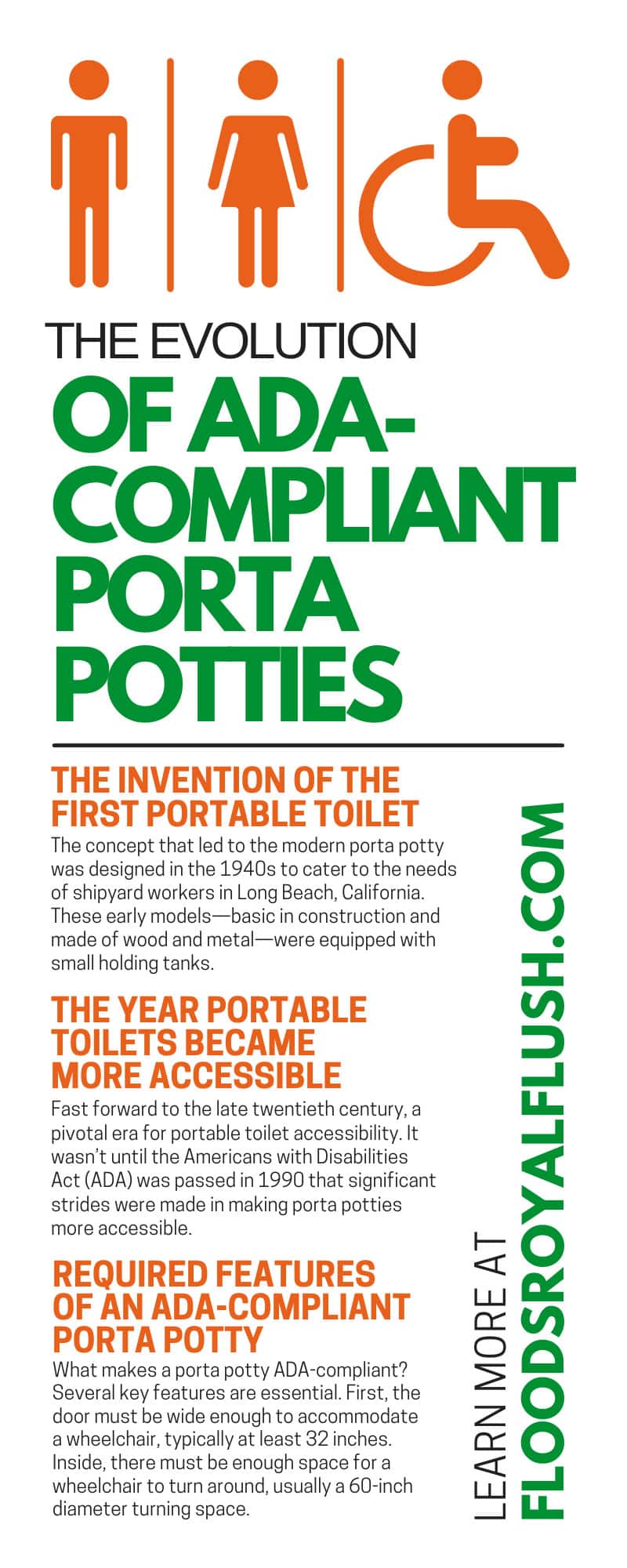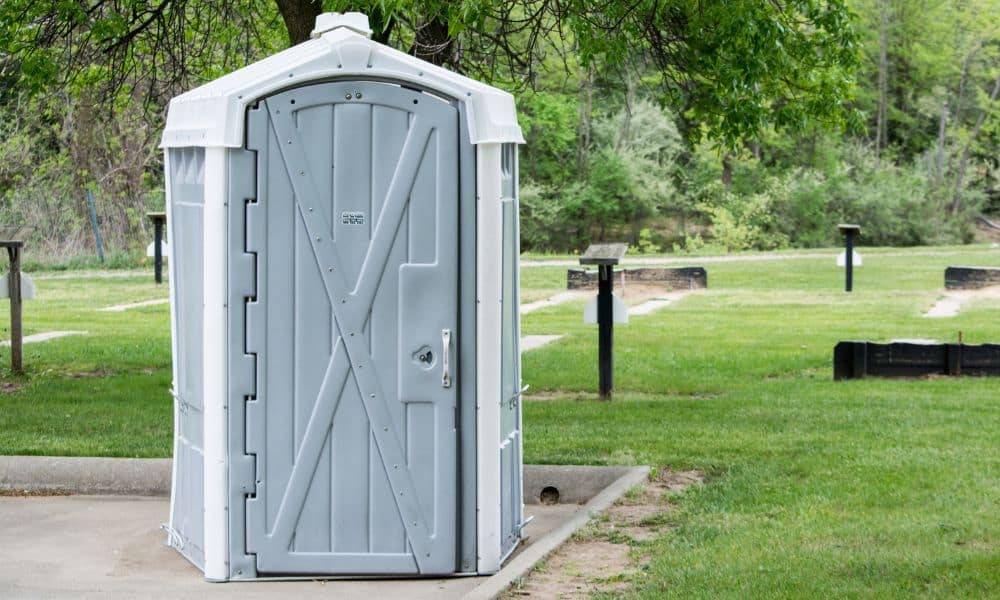Have you ever been to a bustling outdoor event, a lively festival, or even a busy construction site when suddenly, nature calls? You look around and there they are—those familiar porta potties, standing like colorful beacons of relief.
But there’s more to these portable restrooms than meets the eye. They’ve undergone a remarkable transformation throughout the years, evolving into models of inclusivity and accessibility. Today, we’re taking a fun and informative stroll through the evolution of ADA-compliant porta potties. Join us on this journey to discover how these essential amenities have become welcoming spaces for everyone.
The Invention of the First Portable Toilet
Surprisingly, the idea of portable toilets isn’t a modern notion. This concept has roots stretching back to ancient civilizations, where their versions of mobile sanitation, though vastly different, served a similar purpose.
However, the concept that led to the modern porta potty was designed in the 1940s to cater to the needs of shipyard workers in Long Beach, California. These early models—basic in construction and made of wood and metal—were equipped with small holding tanks.
This innovation was born out of necessity, as workers faced long journeys to use the restroom, leading to a significant loss of productivity. While these initial designs were primitive compared to modern standards, they represented a pivotal moment in developing convenient outdoor sanitation solutions.
The Year Portable Toilets Became More Accessible
Fast forward to the late twentieth century, a pivotal era for portable toilet accessibility. It wasn’t until the Americans with Disabilities Act (ADA) was passed in 1990 that significant strides were made in making porta potties more accessible.
This groundbreaking legislation mandated certain standards for accessibility, ensuring that individuals with disabilities had equal access to public facilities, including portable restrooms. Following the ADA, manufacturers began redesigning porta potties to be handicap accessible, marking a new era in porta potty inclusivity and innovation.
These redesigned portable toilets were significantly larger than their predecessors, providing ample space for wheelchair maneuverability. They also featured wider doors, grab bars, and lower toilet seats, catering to a broader range of physical needs. The introduction of these accessible units complied with the legal requirements of the ADA and reflected a growing awareness and respect for the needs of all individuals in public spaces.
Beyond the requirements of the ADA, the evolution of portable toilets continued with advancements in hygiene and comfort. Manufacturers started to incorporate features such as hand sanitizing stations, better ventilation systems, and more pleasant interior designs, making the experience more comfortable for everyone. Some models even began offering baby changing stations and gender-neutral options, further improving their inclusivity.
Required Features of an ADA-Compliant Porta Potty
What makes a porta potty ADA-compliant? Several key features are essential. First, the door must be wide enough to accommodate a wheelchair, typically at least 32 inches. Inside, there must be enough space for a wheelchair to turn around, usually a 60-inch diameter turning space.
Grab bars are a must for support and stability, and they need to be mounted at specified heights. The toilet seat itself should also sit at a specific height to facilitate easier transfers from a wheelchair. Additionally, these units have features like lower toilet paper dispensers and non-slip flooring for extra safety.
Non-slip flooring is a standard feature in porta potties, enhancing safety and reducing the risk of accidents. This thoughtful design complies with ADA standards and maintains a dignified and comfortable experience for all users, regardless of their mobility needs.
Changes to ADA Accessibility Standards
The ADA Accessibility Standards have come a long way. Over time, they’ve become a lot more detailed and useful. Now, these standards cover everything from how steep the paths should be to get to porta potties, to how easy it should be to open doors, and even how things inside should be arranged. These incredible changes mean that porta potties are truly accessible for all.
Additionally, the companies that make these portable restrooms are continually developing new ideas. They listen to feedback from their customers and make changes that provide additional comfort, safety, and accessibility.
The ADA guidelines provide a framework that allows the product to keep improving. Porta potties are now designed to ensure that everything inside works efficiently for a range of people.
Tips for Creating Accessible Restrooms
In addition to the features listed above, it’s important to find ways to make your portable restrooms even more accessible. For example, you should consider having seating options available near your porta potty for those waiting their turn to use the restroom.
You should also recognize that people with chronic illnesses are at a higher risk of infection from germs and viruses that could remain present in the portable facility. Placing hand washing stations from Floods Royal Flush near your porta potties will help keep everyone safer and reduce the risk of germ spread.
By considering the needs of everyone who might use your portable sanitation facility, you can provide restroom access that is functional and inclusive. And don’t forget about the design of your porta potty rentals. Your guests deserve a welcoming and pleasant interior design that enhances the user experience. Fortunately, Floods Royal Flush carries a range of aesthetically pleasing portable toilets that satisfy the requirements for functionality and style.
ADA-Compliant Porta Potties at Floods Royal Flush
From the basic models of the 1940s to the highly modernized versions of today, the evolution of ADA-compliant porta potties reflects our society’s commitment to inclusivity and equal access. The next time you see a porta potty at an event, take a moment to appreciate the thoughtful design and engineering that makes it accessible to everyone. As we move forward, we can expect even more advancements in this field, maintaining the porta potty’s reputation as a symbol of inclusivity and innovation.
To find a handicap-accessible porta potty for your next event, reach out to Floods Royal Flush. We carry a range of ADA-compliant porta potties that provide users with a comfortable and accessible experience. Our state-of-the-art ventilation systems will keep unpleasant odors at bay and the temperature inside the unit stable. Your guests will enjoy the amenities found in our portable restrooms, so be sure to give them the finest service and atmosphere possible.



